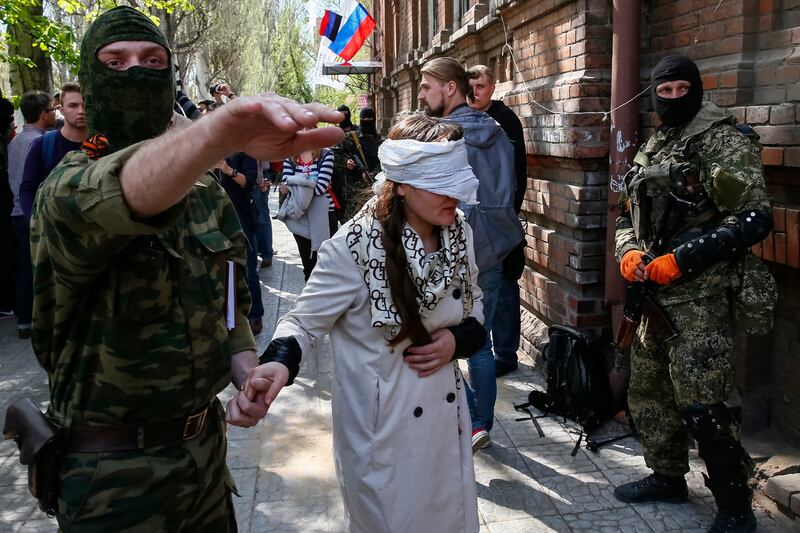The systematic abductions and hostage-holding by the pro-Russian militants in Eastern Ukraine have largely faded from the Western media’s view in the last two weeks after the release of American and European abductees: U.S.-Israeli journalist Simon Ostrovsky, a Vice reporter, and an observer team from the Organization for Security and Cooperation in Europe. Meanwhile, as a just-released United Nations report points out, the problem continues, and Ukraine’s own native victims have been less lucky. Recent stories in the Ukrainian media as well as the still-surviving independent Russian press paint a grim picture of the lawless brutality unleashed in the region with the Kremlin’s help.

A particularly detailed and harrowing account comes from Pavel Kanygin, a special correspondent for the Moscow-based Novaya Gazeta and the only kidnapped Russian citizen so far. Kanygin’s ordeal, during which his captors repeatedly threatened to kill him, lasted only one night; but it has especially ominous overtones because reporting for Novaya Gazeta, one of the very few remaining independent print media in Russia, is a uniquely hazardous job: four of its journalists, including Anna Politkovskaya, have been murdered since 2001.
Kanygin, who has been reporting from Ukraine since December, was grabbed on the evening of May 11 in Artemovsk, a major town in the Donetsk region where he was covering the “self-determination” referendum. Four men approached him in a café when he was having dinner with German journalist Stefan Scholl to voice displeasure with his reportage—specifically, his failure to make it clear that the insurgents were good guys fighting fascist oppression.
After a brief conversation, the two journalists were hustled into a car and driven to the town square, where tensions escalated quickly: Kanygin was berated, accused of spying, and finally set upon by an irate mob. (When Scholl tried to intervene, someone threatened to shoot him.) A Kalashnikov-wielding insurgent leader nicknamed Bashnya—“The Tower”—stopped the beating, but only to force Kanygin into another car. In a particularly chilling moment, Kanygin had to listen to Bashnya and the driver debate whether he should be shot in the woods right away, or taken to the separatists’ headquarters in nearby Volodarka village and then to Slovyansk in the morning—“if he’s still alive.”
At the rebels’ makeshift headquarters, in a tent, Kanygin was forced to strip and ordered to give up the password to unlock his laptop; when he did not comply, Bashnya elbowed him in the face and another insurgent grabbed his hand and threatened to break his finger. (The contents of the laptop, which included a video Kanygin had shot of the protests on Kiev’s Maidan, clinched the case against him as far as his captors were concerned: “Obviously a spy!”) Eventually, after about an hour of interrogation, Kanygin was driven to another camp and turned over to another group of insurgents, with instructions to take him to the rebel-held SBU (Ukrainian Security Service) building in Slovyansk, where the insurgents are keeping most of their prisoners. Luckily for him, the new men in charge had their own ideas—most of them involving money.
After the contents of Kanygin’s wallet (39,000 rubles, or about $1,100) turned out to be disappointing, the insurgents let him use his cell phone to talk to Scholl, who promised to raise another $1,000. “Just remember, it’s not a ransom,” said one of the masked men, “it’s your donation to our cause.” Another added that Kanygin should be grateful he wasn’t going to be taken to the Slavyansk headquarters, where “it’s your FSB people and Chechens … best case scenario, you’ll be sitting in the basement, worst case—well, you know what I mean.”
The bizarre saga continued for a few more hours, with several people including Russia’s human rights ombudsman Vladimir Lukin and New York Times photographer Sergei Ponomarev working behind the scenes to secure Kanygin’s release and with Kanygin forced to withdraw more money from an ATM; in the end, he was drugged and dumped at his hotel in Donetsk.
Another journalist, 24-year-old Ukrainian Serhiy Lefter, a free-lancer who works for Poland’s Open Dialogue Foundation, spent three weeks in the basement at the Slavyansk headquarters that nearly became Kanygin’s destination. Lefter has told Radio Free Europe/Radio Liberty that he was beaten several times—mostly in an attempt to make him confess to spying for the Ukrainian paramilitary nationalist group, Right Sector—and was allowed to leave the basement only to use the toilet or help with cleanup in the yard; still, he says that hostages from the media were generally treated better than the insurgents’ other prisoners. (In a particularly grisly story, coal miner Oleksandr Hurov, who was held at a different location in Donetsk after the militants seized him for ripping down a separatist flag, not only suffered beatings that left him with a broken arm and a fractured jaw but had a Ukrainian nationalist tattoo scraped off his arm with a broken bottle.)
Serhiy Shapoval, a reporter for the Ukrainian local newspaper Volyn Post, remains captive. So do Pavel Yurov, 33, a prominent Kiev theatrical producer, and artist Denis Grishchuk, 29. The two, both natives of Eastern Ukraine, traveled to Slavyansk on April 25, apparently to get firsthand impressions for an upcoming production of a play that deals with current events in Ukraine—and went missing after members of the Donetsk “people’s militia” detained them for questioning. Lefter has confirmed that, as of early May, Yurov and Grishchuk were being held at the SBU building in Slavyansk. The cause of their detention? According to Lefter, a Ukrainian flag in their possession and, possibly, pro-Maidan posts in their social media accounts.
Perhaps the most mysterious of the captives is 29-year-old journalist and activist Irma Krat. Krat, the editor-in-chief of a minor newspaper, Svoboda Slova (“Freedom of Speech”) in the Poltava region, is a rather eccentric figure; in 2012, during an unsuccessful run for the parliament, she made news by dumping a bucket of muddy water on the head of a local mayor at a town council meeting in retaliation for what she said was a mud-slinging campaign against her. (Some journalists came to her defense.) In February, she organized a Maidan “women’s brigade” whose prominence in the protests or the street battles is unclear; Ilya Barabanov, a correspondent for the newspaper Kommersant, believes her role was artificially inflated by Russian propaganda, which turned her into a fearsome female commando—partly because she has a name that fit the image of a Nazi she-devil.
Krat was seized on April 20 in Slovyansk, where she said she had come to report on a violent clash near a separatist checkpoint that left three pro-Russian militants dead. The next day, she was trotted out for what Ostrovsky called “the world’s weirdest press conference,” in which a masked gunman brought her out blindfolded, then removed the scarf tied around her face, allowed her to speak to journalists and blindfolded her once against before leading her away. In an echo of the militants’ bizarre claim that the captured OSCE observers were “guests” who nonetheless couldn’t be allowed to leave just yet, the man escorting Krat told the press that she was not being held against her will. A separatist spokesman also said that Krat was held on suspicion of involvement in “war crimes,” including the murder and torture of Berkut riot squad members on the Maidan.
A few days later, Krat had an even more bizarre appearance on Russia’s NTV, a state channel known for particularly scurrilous political character assassination. The program, billed as “the confession of the Right Sector spy,” featured an interview with Krat, conducted by an NTV journalist in a room inside the SBU building. A typical propaganda concoction, the 40-minute report spliced together bits from Krat’s interview, Maidan footage that showed her doing nothing more sinister than addressing the crowd, and video (apparently from Krat’s own camera) in which she tried to question one of the mysterious “green men” who conducted the Crimea takeover. (In the same video, Krat freely admitted that she was trying to provoke the soldier into arresting her—the only offense of which the program actually managed to convict her.)
Despite clearly selective editing of the interview footage, it was obvious that Krat was not actually confessing to any crimes—at one point she even asked the interviewer if there was any evidence to back up the accusations—or admitting membership in the Right Sector. Nor was she recanting her pro-Maidan views, though she was critical of the interim government in Kiev and spoke of her concern with the possibility of civil war. In a rather chilling touch, at the end of the interview Krat herself put her blindfold back on before being led back to her prison. There has been no news of her since April 26, when the program aired on NTV.
In the chaos of Eastern Ukraine, it is hard to tell how many people are being held captive, or what accounts should be regarded as credible. A particularly disturbing recent report in the Ukrainian media says that pro-Maidan activist Mikhail Logvinenko is being held and systematically abused by separatists in Lugansk; photos and videos (one of which has been removed from YouTube) shows a man said to be Logvinenko being led around on all fours on a dog leash while being beaten and kicked by his captors.
It is also impossible to tell whether any Russian personnel are directly involved in the abductions; Lefter has said that his captors were all local insurgents. But, in a larger sense, Russia’s role in these events is not in doubt. If nothing else, the fact that Russian state television interviews hostages and treats the hostage-holders as heroes is bad enough.






